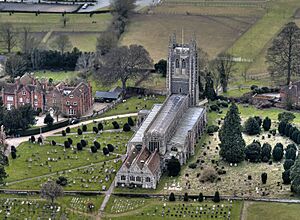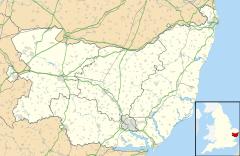Long Melford facts for kids
Quick facts for kids Long Melford |
|
|---|---|
 Holy Trinity Church |
|
| Area | 21.95 km2 (8.47 sq mi) |
| Population | 3,918 (2011) |
| • Density | 178/km2 (460/sq mi) |
| OS grid reference | TL8646 |
| Civil parish |
|
| District |
|
| Shire county | |
| Region | |
| Country | England |
| Sovereign state | United Kingdom |
| Post town | Sudbury |
| Postcode district | CO10 |
| Dialling code | 01787 |
| Police | Suffolk |
| Fire | Suffolk |
| Ambulance | East of England |
| EU Parliament | East of England |
| UK Parliament |
|
Long Melford, also known as Melford, is a large village in Suffolk, England. It sits right on the border with Essex, next to the River Stour. It's about 5 km (3 miles) from Sudbury, 26 km (16 miles) from Colchester, and 23 km (14 miles) from Bury St Edmunds.
Long Melford is famous as one of Suffolk's "wool towns," meaning it was important for making wool products long ago. It used to be a market town too. Small areas called Bridge Street and Cuckoo Tye are also part of the village. In 2011, about 3,918 people lived here.
The village's name comes from its long shape, stretching about 5 km (3 miles) along one road. "Melford" comes from "Mill ford," which was a place where people crossed the Chad Brook, a small stream that flows into the River Stour.
Contents
A Look Back: Long Melford's History
Early Settlements
People have lived in the area now known as Long Melford for a very long time. In 2011, discoveries showed that early people lived here during the Mesolithic period, around 8300 BC. Later, during the Iron Age, more signs of settlement were found in the same central part of the village.
The Romans built two Roman roads through Long Melford. The main road connected Chelmsford to Pakenham. In 1828, Roman remains were found in a gravel pit, where the village's football club is now. Even more Roman items, including full skeletons and pottery, were found in a villager's garden in 1997.
In 2013, archaeologists from Cambridge University found evidence of Saxon and Bronze Age settlements in the northern part of the village.
The Middle Ages
Around 1050, the area of Melford was given to the Abbey of St Edmundsbury. The village is mentioned in the Domesday Book of 1086. This old record shows that Melford had 41 villagers, including farmers and slaves. There were also mills, meadows, and woodlands.
During the Middle Ages, Long Melford grew. It gained a weekly market and an annual fair in 1235. The village survived the terrible Black Death in 1348-1349. It was also a brief stop during the Peasants' Revolt in 1381.
By the early 1400s, the Kentwell estate belonged to the Clopton family. John Clopton was arrested in 1461 but was later released. He returned to Kentwell and helped pay for the rebuilding of the local church. This church is a famous example of a "wool church," built with money from the wool trade. At this time, many villagers were becoming wealthier. They rented their homes and land, and Guilds were formed. Weaving cloth became a very important part of the village's economy. In 1446, there were 30 weavers in Long Melford who made 264 finished "cloths."
After the Dissolution of the Monasteries, King Henry VIII gave the land to Sir William Cordell.
Modern Times
In 1604, the plague hit Melford, and 119 people died in just a few months. During the English Civil War, a large group of people called Puritans came to Melford. They were chasing Elizabeth Savage, Countess Rivers, who supported the King. They attacked her home, Melford Hall, and she had to flee.
By the late 1600s, making cloth became important again. New types of lighter, cheaper cloth like 'Bays and Says' (similar to baize and serge) were produced. Many cloth merchants became very rich, bringing good times back to Melford.
In the early 1800s, new industries started in Melford. These included weaving horsehair, an iron factory, and making coconut mats. By 1851, three horsehair factories employed over 200 people. In 1865, Prince Bertie (who later became King Edward VII) and Princess Alexandra visited the village. Large arches were built to welcome them.
In the 1880s, workers in the coconut industry faced pay cuts. This led to anger and a strike. Things got out of hand, and a riot broke out in December 1885. Soldiers had to be called from Bury St Edmunds to calm things down.
Long Melford in the World Wars
During World War I, hundreds of men from Long Melford joined the army. They fought in places like Gallipoli, Ypres, and the Somme. Others served in the Royal Navy and the new Royal Flying Corps. A book called Long Melford and the Great War tells the stories of these 1,100 men. In October 1920, the village war memorial was revealed at Holy Trinity Church.
During World War II, Long Melford was a busy place for American and Allied soldiers. They flew large bomber planes like the B24 and B17 from nearby airfields. Soldiers from different regiments stayed in the village. Injured airmen, soldiers from the D-Day landings, and prisoners of war were treated at a large hospital nearby. The famous band leader Glenn Miller even visited the hospital in 1944 to play music for the injured.
German and Italian prisoners of war were held in camps near Long Melford. By the end of the war, several planes had crashed in the area, causing deaths and injuries. Many small concrete bunkers, called pillboxes, were built in the village for defense. A hidden underground bunker was found in 2012. The church memorial shows that 96 villagers died in World War I, and 11 died in World War II.
Important Buildings
The Holy Trinity Church is very large and impressive for a village church. It's one of the best "wool churches" in East Anglia. The church was mostly rebuilt between 1467 and 1497 by John Clopton of Kentwell Hall. It is known for its beautiful stone patterns, special chapels, and amazing medieval stained-glass windows. The poet Edmund Blunden is buried in the churchyard. Next to the church is the Hospital of the Holy and Blessed Trinity, an old almshouse (a place for poor people to live) founded in 1573.
Long Melford has two grand country houses: Kentwell Hall and Melford Hall. Both were visited by Queen Elizabeth I in the 1500s. These houses were built with money from the successful wool trade. The Clopton family helped pay for Kentwell Hall and Holy Trinity Church. Both Kentwell Hall and Melford Hall are open to visitors. Melford Hall is looked after by the National Trust.
The village has 100 listed buildings, including many old inns along its main street. You can learn about the village's past at the Long Melford Heritage Centre. It has old photos and ancient items found in the village, including Roman artifacts.
Education in Long Melford
Long Melford has one school, Long Melford Church of England Primary School. It opened in 1974. The village's older school building, built in 1860, is now a community center.
Getting Around
Long Melford used to have a train station on the Stour Valley Line, but it closed in 1967. Now, you can travel to nearby towns like Sudbury, Colchester, Bury St Edmunds, Haverhill, and Ipswich by bus.
Sports and Fun
Long Melford has a football club called Long Melford F.C.. They play at the Stoneylands ground. They were promoted to the Eastern Counties League Premier Division in the 2014/15 season.
The village has a large, long village green. Until the 1980s, it had many huge elm trees, including one of the biggest in England. These trees were even painted by the artist S. R. Badmin in 1940.
Long Melford has a large water meadow and many walking paths. The Melford Walk follows an old railway line. The Suffolk Cycle Route also goes through the village. At the southern end of the village, near the River Stour, is Long Melford Country Park. This park has attractive lakes and places for wildlife. It was created from gravel pits used during World War II.
Every November, the Long Melford Big Night Out Guy Fawkes Night fireworks event is held at Melford Hall.
Famous People from Long Melford
Many interesting people have connections to Long Melford:
- John Reeve (1479-1540), the last abbot of Bury St Edmunds, was born here.
- Sir Roger Martyn, who was Lord Mayor of London in 1567, was also born here.
- The World War I poet Edmund Blunden lived in Long Melford and is buried in the churchyard.
- The opera singer Mignon Nevada died here.
- Racing driver Richard Seaman lived at Kentwell Hall when he was a child.
- England international footballer William Cobbold was born in the village.
- Henry Wickham Steed, who was the editor of The Times newspaper, was born here.
- The children's author Beatrix Potter often visited Melford Hall between 1899 and 1916. She was a cousin of Ethel, Lady Hyde Parker, who lived there.
- In the 1900s, the artist Francis Bacon visited Long Melford regularly. His friend John Edwards later bought a house there.
- The wood engraver and artist Lady Mabel Annesley retired to Long Melford in 1953 and is buried in the village.
- The lawyer and politician Andrew Phillips, Baron Phillips of Sudbury, was born in Long Melford.
- The classicist and expert on ancient languages Professor H W F Saggs died here in 2005.
- Anne Cullen, an actress from the radio show The Archers, lived in Long Melford until she passed away in 2015.
See also
 In Spanish: Long Melford para niños
In Spanish: Long Melford para niños


